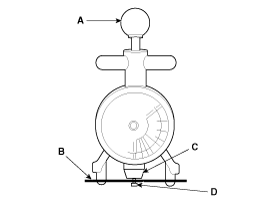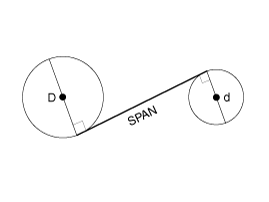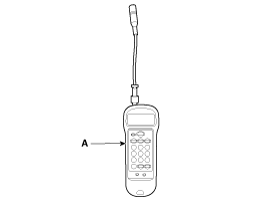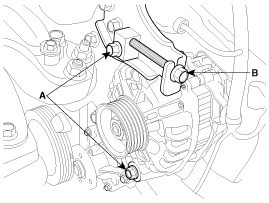While pressing the handle (A) of the gauge, insert the belt (B) between pulley and pulley (or idler) into the gap between spindle (C) and hook (D).

Measure the belt tension using a mechanical tension gauge or a sonic tension meter.
Tension
New Belt :
961.0 ~ 980.7 N (98.0 ~ 100.0 kgf, 216.1 ~ 220.5 lbf)
Used Belt :
637.4 ~ 735.5 N (65.0 ~ 75.0 kgf, 143.3 ~ 165.3 lbf)
If the engine has run for 5 minutes or more, the belt tension must be adjusted as a used belt.
When installing the V-ribbed belt, all grooves on the pulley should be covered with belt ribs.
A loose belt causes slip noise.
Too tight belt cause bearing of alternator and water pump to damage.
While pressing the handle (A) of the gauge, insert the belt (B) between pulley and pulley (or idler) into the gap between spindle (C) and hook (D).

After releasing the handle (A), read a value on the dial pointed by the indicator (B).

Input the belt specifications into the tension meter.
Belt type | Location of measurement | Input data | ||
M (Mass, g/m.rib) | W (Width, rib) | S (Span, mm) | ||
With A/C | Crankshaft pulley to A/C compressor pulley | 13.4 | 6 | 178.9 |
Without A/C | Idler to alternator pulley | 13.4 | 6 | Actual measurement value |
Measurement of S (Span) : Caculate average value after measuring the distance 3~4 times.

D : Idler
d : Alternator pulley

Locate the micro phone (B) close to the center of belt span (A) and bounce the belt by finger 2~3 times. Read a value on the display.


Loosen the alternator mounting bolts (A).
Tighten the adjusting bolt (B) clockwise in loose tension ; loosen the bolt counterclockwise in high tension.

Recheck tension of the belt.
After adjusting tension, tighten the alternator mounting bolts.
Tightening torque
M8 bolt :
19.6 ~ 26.5 N.m (2.0 ~ 2.7 kgf.m, 14.5 ~ 19.5 Ib-ft)
M10 bolt :
29.4 ~ 41.2 N.m (3.0 ~ 4.2 kgf.m, 21.7 ~ 30.4 Ib-ft)